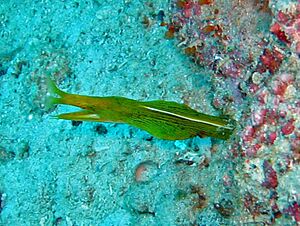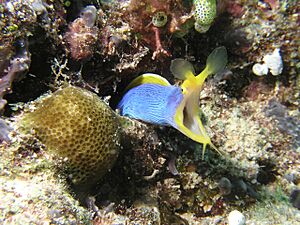Ribbon eel facts for kids
Quick facts for kids Ribbon eel |
|
|---|---|
 |
|
 |
|
| Male (above) and female (below) in Borneo | |
| Conservation status | |
| Scientific classification | |
| Synonyms | |
|
Rhinomuraena amboinensis |
The ribbon eel (Rhinomuraena quaesita) is a special type of moray eel. It's the only member of its group, called Rhinomuraena. You can find these eels living in sand burrows and coral reefs in the Indo-Pacific Ocean. While most people put them in the moray eel family, some scientists think they are unique enough to have their own family!
Contents
Life Cycle and Appearance
Ribbon eels are active during the day. They have a long, thin body and tall fins on their back. You can easily spot them by their wide-open jaws and special flared nostrils. These eels have many bones in their back, up to 255! This makes them one of the longest and thinnest eel species known.
Baby ribbon eels, called leptocephalus larvae, are large and greenish. As they grow, ribbon eels change their color and even their gender. This is called being a protandic hermaphrodite, meaning they start as male and can change to female.
When they are young, ribbon eels are mostly jet black with a yellow fin on their back. As they become adult males, their black color changes to a bright blue. Their face turns yellow. Adult females are usually all yellow, or yellow with some blue near their tail. This color change linked to gender is very rare among moray eels!
Blue adult males are about 65 to 94 centimeters (26 to 37 inches) long. The larger yellow females can grow up to 130 centimeters (51 inches). Even with these amazing color changes, scientists believe color doesn't help them find mates. This is because ribbon eels are colorblind. They can only see shades, not true colors. In the wild, ribbon eels can live for up to twenty years.
Where Ribbon Eels Live
Ribbon eels like shallower waters compared to other moray eels. They usually live at depths from 1 to 57 meters (3 to 187 feet). These eels are found in many places. Divers often see them in Indonesian waters. They poke their heads and front bodies out of cracks in sand and rocky areas.
They love places like coral reefs. Their slimy skin helps them slip easily through tight spots. You can typically find ribbon eels in warm parts of the Indian and Pacific Oceans. Their home stretches from East Africa to southern Japan, Australia, and French Polynesia.
Protecting Ribbon Eels
The ribbon eel is listed as "least concerned" on the IUCN Red List of Threatened Species. This means they are not currently in danger of disappearing. However, recent studies show some things could threaten them.
Marine eels that live in shallow waters, especially near coral reefs, are most at risk. This is because of coral bleaching and other damage to their homes. These problems are caused by climate change or human actions like pollution. When their habitat changes, it can be harder for ribbon eels to find food and reproduce. Too much fishing, called overfishing, is another worry. It can reduce the number of ribbon eels and the small animals they eat.
Ribbon Eels in Aquariums
Most ribbon eels do not live longer than a year when kept in home aquariums. They often stop eating after being caught and placed in tanks. Public aquariums have had more success. Some have even reported that ribbon eels have laid eggs there! In captivity, the color changes seen in the wild don't seem to be linked to how old the eel is or its gender.
Even though they are caught for the aquarium trade, ribbon eels are still common and found in many places. They are not considered a threatened species.




